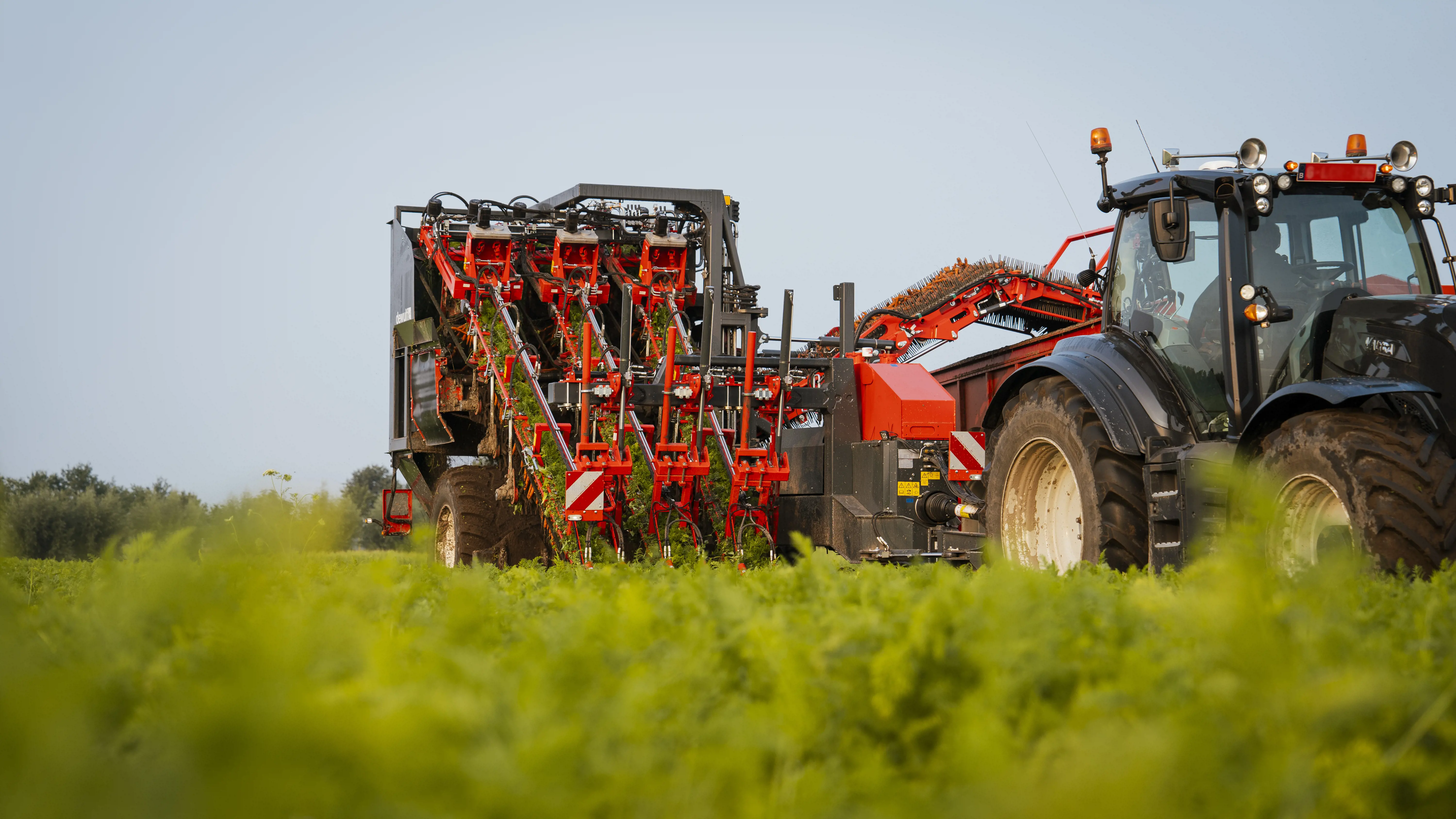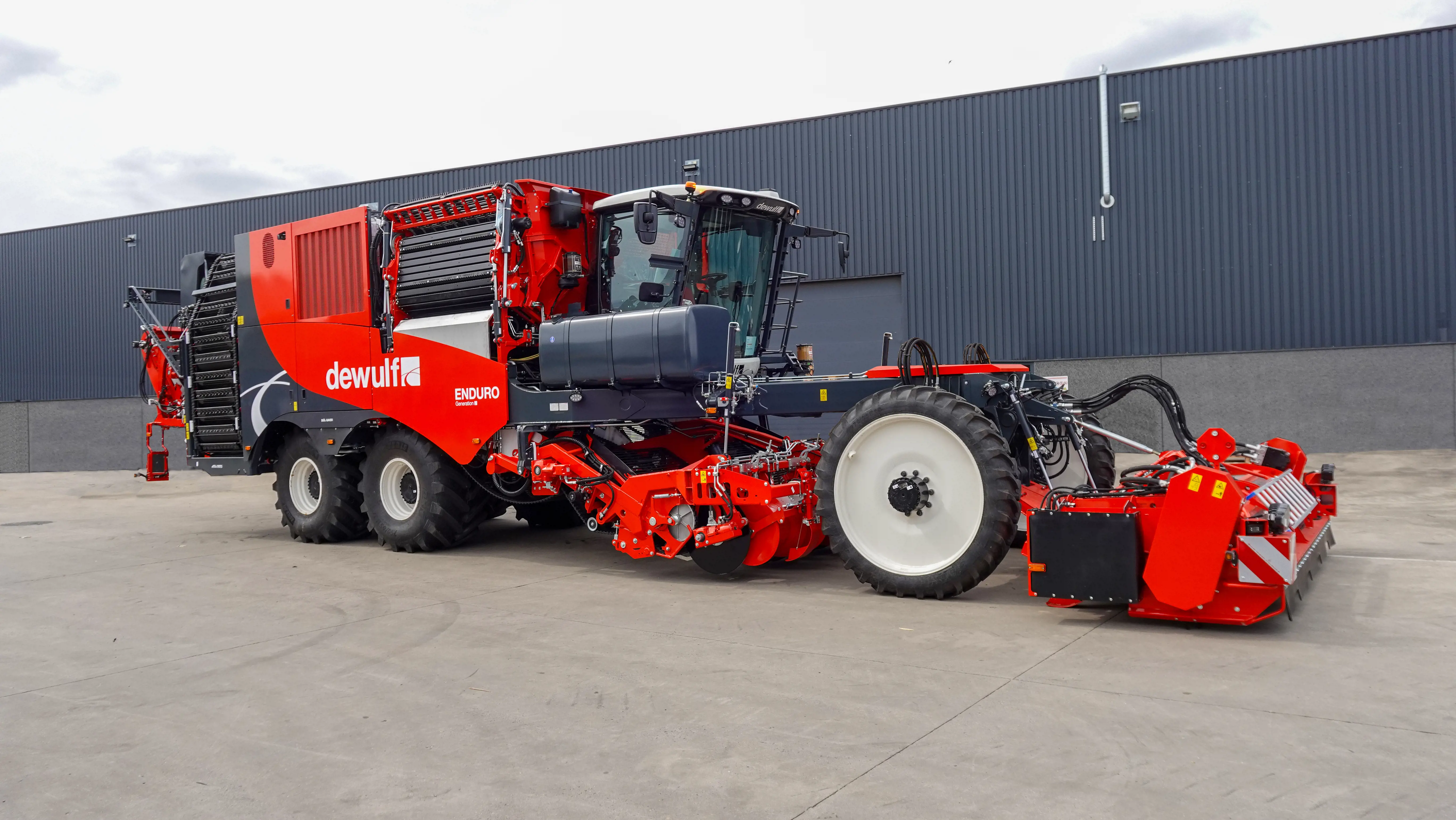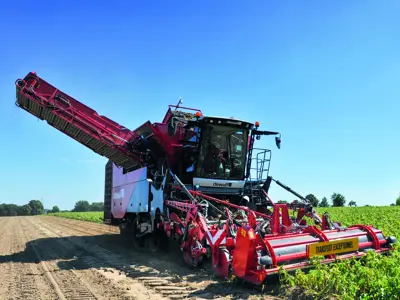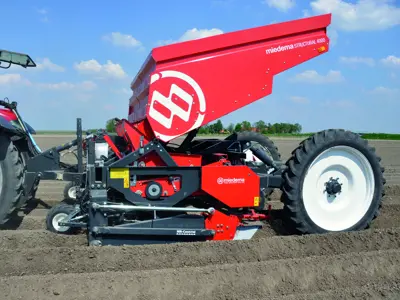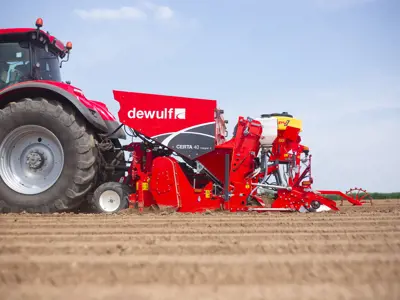Dewulf showcases new and proven technology at Interpom
12/11/2024
Enjoy growing NeXt level
Dewulf, leading manufacturer of agricultural machinery for the cultivation of potatoes and root crops, will also be exhibiting at Interpom this year, the premier European indoor trade fair for the potato sector in Kortrijk. From 24 to 26 November, Dewulf will welcome visitors in hall 4, stand 413/414, where both innovative and proven technologies in planting, harvesting and storage will be showcased to the public. This year, Dewulf is bringing nine different machines, including two machine innovations and a technological breakthrough making their debut at the trade fair.
The tried and true R3060 gets a facelift and a boost in ease of use
Since the launch of the R3000 in 1989, Dewulf can look back on more than 35 years of experience in the construction of self-propelled 2-row harvesters. At Interpom, Dewulf presents a facelift of the current R3060 generation. The updated harvester, in addition to its new look and feel, is equipped with the spacious X11 Claas cabin, designed for a pleasant and user-friendly working environment, revolving around the driver. The N-joystick, with its ergonomic design and buttons within thumb's reach, ensures extremely comfortable operation. The new touchscreen, with specially developed in-house software, makes the controls and user interface highly intuitive. With up to ten touchscreen cameras, the user gets an excellent overview of the product flow. An optional Premium cabin, with active ventilation in the leather seat and up to 15° of rotation, provides extra comfort during unloading on the move.
Level X-IoT[1]: neXt level innovation combined with efficiency
With advanced IoT integration on the updated R3060 and the second-generation Enduro harvester, Dewulf takes a new step in efficiency. Under the banner ‘Level X,’ the machine manufacturer aims to simplify the lives of the driver, operator and/or owner through IoT. Additionally, thanks to extensive (external) connectivity options, service technicians, the company owner and, for example, the trailer driver can accurately monitor the harvesting process and yield at any time.
This system provides real-time insights by monitoring important parameters such as GPS position, fuel and AdBlue levels, speed and machine modes such as harvesting, unloading on the move and turning. Field data, including the harvested area per field and productivity (ha/hour), are also recorded with precision. These data not only provide growers and contractors with a clear overview of performance but also support optimisation of the harvesting process and the associated administration that follows.
The Level X core functionality lays the foundation for future expansions of Dewulf applications, further supporting customers in fine-tuning and automating harvesting processes. Thanks to IoT integration, both harvesters are future-ready and provide both end-users and dealers with new insights and tools to further enhance efficiency and elevate productivity. Enjoy growing neXt level, from 1 to X.
The MG 240 optical sorter addresses a variety of needs
The MG 240 is a mobile, three-way sorting unit designed for various types of growers. With advanced sorting technology, the MG 240 can individually separate usable product from green potatoes as well as from clods and waste. The integrated system provides a 360° view of the product, allowing for precise sorting. This 2.4-metre sorting unit, mounted on a frame with intake and waste conveyors and extra mats to slow down the product, can function as a stand-alone machine and is easily placed behind almost any receiving hopper, offering maximum flexibility. The optical sorter is equipped with its own electrical box and air compressor. With a target capacity of 60 tonnes per hour, this unit is ideal for growers looking to automate. The independently adjustable speeds of the conveyor belts and mats ensure optimal performance.
The following machines from the product range are also making their way to the Kortrijk expo halls:
- Miedema Structural 4000: Trailed 4-row belt planter with a bunker capacity of 4000 kg, offering exceptional precision not only in placing the potatoes but also in providing the seed potatoes with the exact space needed for optimal growth. The renowned, original Structural belt planting system combines extreme planting accuracy with a high driving speed (up to 12 km/h).
- Dewulf Certa 40 Integral: This complete solution in planting technology combines soil cultivation, planting and ridging in a single operation. The updated Erosion-Stop is also a highlight. The Certa 40 Integral is available in both 4 x 75 cm and 4 x 90 cm variants and operates based on ISOBUS, from controller to software. The in-house designed system can be supplied with a 12-inch Topcon touchscreen and joystick.
- Dewulf Enduro: In 2024, Dewulf began construction of the second generation of its 4-row sieving harvester on tyres. Some of the developments on the Level X-equipped machine? Availability in both 4 x 75 cm and 4 x 90 cm row spacing, increased the processing capacity of the ring elevator, and a 550 hp engine alongside the 450 hp variant from Scania. The two-part bunker of the flagship model, with its convenient 12.3 m³ capacity, is the largest in its market segment. In terms of (lowest) ground pressure (max. 1.8 kg/cm²), Dewulf's self-propelled harvester also tops the list. The Enduro, though a tyre-mounted harvester, delivers unmatched traction even in the most demanding conditions. Finally, in its second generation, the machine remains exceptionally accessible for drivers due to the ergonomics and tremendous ease of use in the cabin.
- Dewulf Kwatro: With this 4-row machine, Dewulf is bringing to Interpom a 4-row machine that has more than earned its stripes in recent years. The machine combines a classic sieving path, hedgehog unit, cleaning modules and the largest bunker on the market. The self-propelled harvester allows frontal harvesting, resulting in an extremely high-quality product. Even in the most challenging, wet conditions, the Kwatro proves to be a very stable and reliable master of the field. As the traction can be adjusted per track/wheel, it is almost always possible to harvest. Add to this the tremendous manoeuvrability, and you know you have a real top machine in the 4-row harvester segment.
- Miedema MH 241 Scotts Evolution: The receiving hopper is equipped with the Scotts Evolution system, which offers the widest working range, as it provides product-friendly processing in both dry and the most challenging, wet conditions. The Scotts cleaning unit is equipped with eight spiral rollers, each fitted with six ribs, for intensive cleaning.
- Miedema ML 1980: Fully automatic store loader, 19 metres long and 80 cm wide, with X-Stream conveyor. Through use of the Premium filling function, this machine can fill a store completely automatically – without supervision – in perfect layers and with care for product-friendliness.
- Dewulf MB 34: Within the domain of storage, the MB 34 plays a central role. Dewulf's latest box filler is fully electrically powered and nods the filling conveyor into the box, keeping it nicely on the ground during filling. The energy-efficient MB 34 features two box stops that make it suitable for box lengths ranging from 120 to 260 cm. The product guidance flap contributes to symmetrical box filling, which in turn ensures optimal ventilation during the storage season. The box filler directly drives an ME 3-70 elevator conveyor, the infeed height of which is adjustable using a jack at the bottom. End of the fair? By folding in the box stops and pressing a single button, the MB 34 shifts to its compact mode and is ready for transport!
[1] Internet of Things (IoT) refers to the network of physical devices, vehicles, buildings and other objects embedded with sensors, software and connectivity. These devices can collect and exchange data, making them ‘smart’ and enabling them to interact with their environment.

 English
English
 Nederlands
Nederlands
 Deutsch
Deutsch
 Français
Français
 Polski
Polski
 Espagnol
Espagnol
 русский
русский
